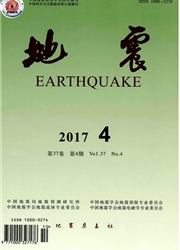

 中文摘要:
中文摘要:
本文利用东北地区的黑龙江、吉林、辽宁和内蒙古等四省区区域数字地震台网122个宽频带地震台站记录的波形数据,分别通过背景噪声互相关及地震面波提取8~25s和25~70s的瑞利面波频散曲线,进而反演得到东北地区从浅到深直至约100km的岩石圈速度结构。结果表明,周期为8s至15s的短周期群速度分布与地表构造特征有较好的对应关系,盆岭边界的大型断裂对上地壳速度结构的控制作用明显,松辽盆地呈现较厚的低速沉积盆地特征;周期为20s至30s的群速度与短周期时相比出现明显变化,反映了以大兴安岭—太行山重力梯度带为界,西部地区莫霍面深度大于东部地区;周期为50s至70s的长周期群速度图表现为随着周期的增加,东部低速区域西移而西部显示稳定高速,可能反映了研究区受太平洋板块俯冲影响,大兴安岭以东地区软流圈热物质上涌的特征。
 英文摘要:
英文摘要:
We have inverted Rayleigh wave dispersion measurements to image the group velocity structure of the lithosphere under the northeastern China to a depth of about 100 km,using waveform data recorded by 122 broadband stations of Heilongjiang,Jilin,Liaoning and Inner Mongolia digital seismic networks.Rayleigh wave group velocities at periods of 8~25 s and 25~70 s were measured from ambient noise cross-correlation and surface wave,respectively.At the short periods of 8~15 s,group velocities are notably correlated with the surface geology and controlled apparently by the large faults dividing basins and ranges.Beneath Songliao Basin,the significant low velocity suggests there is relatively thick sediment.Compared with the group velocities of 8~25 s periods,velocities at periods of 20~30 s change drastically,which reveal that Moho depths in the western regions of North-South gravity lineament(NSGL) are deeper than that in the eastern regions.At the long periods of 50~70 s,with the increase of the periods,the low-velocity in the eastern regions move westward;meanwhile,the western regions show stable high-velocity features.The results may suggest asthenospheric upwelling under the eastern regions of NSGL which may be affected by the subduction of Pacific slab.
 同期刊论文项目
同期刊论文项目
 同项目期刊论文
同项目期刊论文
 期刊信息
期刊信息
